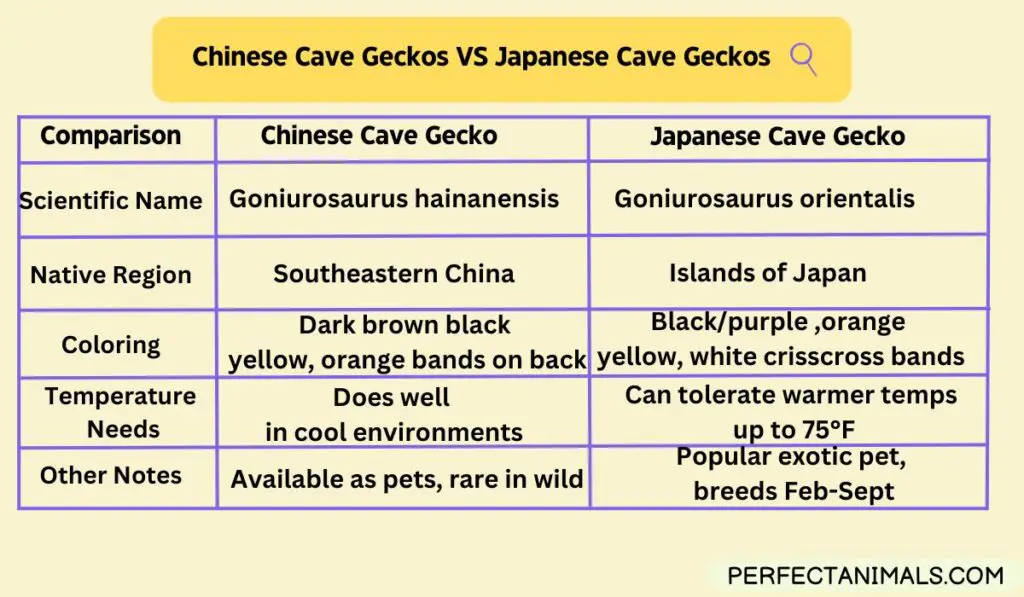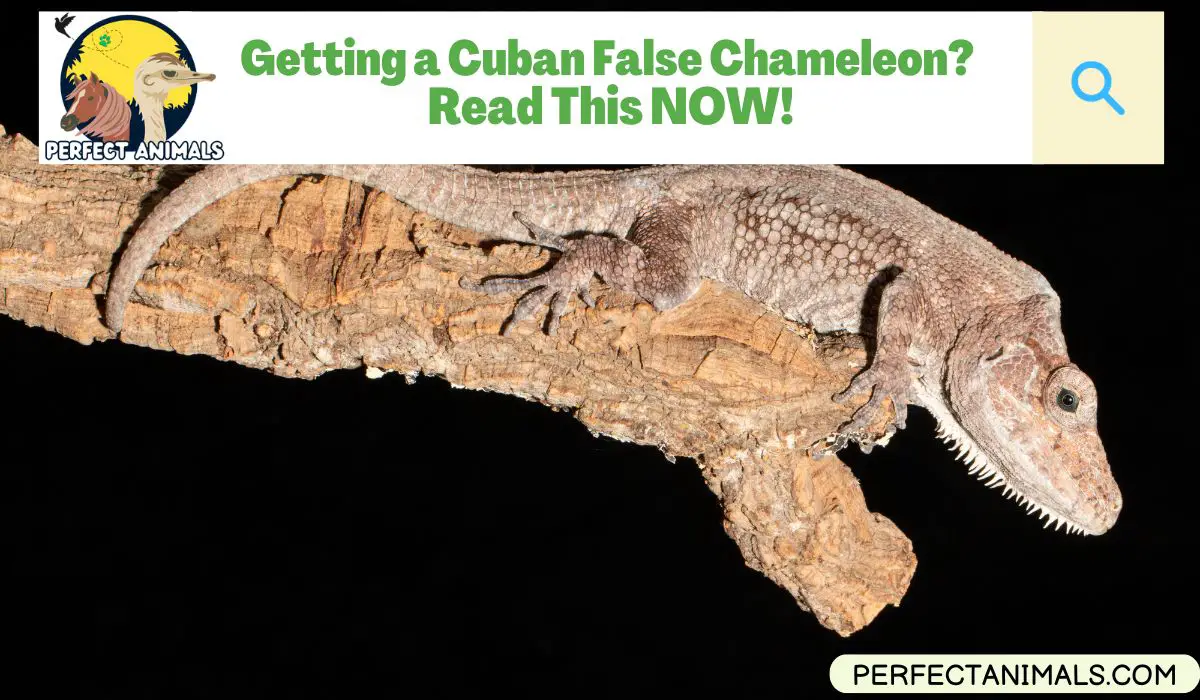Chinese cave geckos are fascinating little lizards that make for unique pets.
With their large eyes, flat bodies, and insectivore diets, these geckos have adapted perfectly to living in dark caves.
Their cave-dwelling nature also gives them a prehistoric, almost alien-like appearance that many reptile lovers find appealing.
In this article, we’ll dive into everything you need to know if you’re considering getting one of these intriguing creatures as a pet.
We’ll cover what they look like, their personalities, ideal habitat setups, care requirements, breeding behaviors, and more.
By the end, you’ll have a solid understanding of whether or not a Chinese cave gecko is the right exotic pet for you.
Are Chinese Cave Geckos Good Pets?
In my experience, Chinese cave geckos can make great pets for the right owner. I’ve had a few over the years and have found them to be relatively easy to care for as far as reptiles go.
The main things I love about my Chinese cave geckos are that they are docile, low-maintenance, and have unique personalities.
They tolerate regular handling very well and seem comfortable around people.
I’ve even had a couple that enjoy sitting on my shoulder while I watch TV!
Of course, they do require a properly set up terrarium with appropriate heating and humidity.
And you need to be prepared to feed them live insects.
But overall, Chinese cave geckos are definitely on the more beginner-friendly end of the spectrum when it comes to pet reptiles.
My friends who own Chinese cave geckos seem to agree that they make enjoyable pets.
These creatures tend to be active at dusk and dawn, so you can have fun observing their quirky behaviors during those times.
Just make sure you do plenty of research ahead of time so you can meet all of their care needs.
Related Article – Timor Monitor Care Guide
What Color Are Chinese Cave Geckos?
Chinese cave geckos display a range of colors and patterns.
The most common background colors are light tan, pale gray, black, purple, and even shades of orange or yellow in some specimens.
Many have spots or stripes in black, brown, purple, or orange running along their backs and tails.
The specific spots and patterns can vary quite a bit between individuals.
One of the most distinctive features is their bright reddish-orange, orange, or yellow eyes. This eye coloration helps them see well in the dark caves and crevices of their native habitat.
Hatchlings and juveniles tend to have more vivid coloring and patterns, which may fade or change as they mature into adults.
However, most adults retain at least some signature spots, stripes, or mottling.
The geckos can also slightly alter their coloring based on temperature, substrate, and mood.
But the combination of earthy tones like tan, gray, brown, and black mixed with pops of color like purple, orange, or yellow, plus those fiery eyes, creates a uniquely beautiful appearance.
Related Article – Getting a Cuban False Chameleon? Read This NOW!
Are Chinese Cave Geckos Rare?
In the wild, Chinese cave geckos are considered rare and fairly elusive.
This is because they inhabit remote, hard-to-reach cave systems in parts of southern China.
Their very specific habitat makes spotting these geckos in their natural environment unlikely for the average person.
However, Chinese cave geckos are bred in captivity relatively frequently around the world these days.
So while you may not stumble across one in the wild, they aren’t too challenging to obtain through a reputable exotic pet breeder or specialty reptile store.
What is the Difference Between Chinese Cave Geckos And Japanese Cave Geckos?
Chinese cave geckos and Japanese cave geckos are two distinct species within the genus Goniurosaurus. While they share some common traits, there are several key differences between these fascinating geckos.

Chinese cave geckos, with the scientific name Goniurosaurus hainanensis, come from subtropical rainforests in southeastern China.
They have dark brown to black skin with yellow or orange banding along their backs.
Japanese cave geckos, Goniurosaurus orientalis, originate from the islands of Japan.
They display black and purple hues with orange, yellow, and white crisscross banding patterns.
Both species lack sticky toe pads and cannot climb smooth surfaces.
However, Chinese cave geckos are better adapted to climbing with sharp claws to gain traction.
Japanese cave geckos prefer slightly warmer temperatures up to 75°F compared to Chinese cave geckos that do best in cooler environments.
In terms of habitat, Japanese cave geckos require more humidity and misting to stay happy and healthy.
Chinese cave geckos are a bit more flexible in their moisture and temperature needs.
While these two geckos share an intriguing cave-dwelling ancestry, their differing natural habitats, physical traits, and housing requirements demonstrate that they are distinct species.
Related Article – Bearded Dragon Tail Rot
Chinese Cave Gecko for Sale | How Much Are Chinese Cave Geckos?
I recommend doing thorough research before bringing home any new pet, especially a more exotic species like a Chinese cave gecko.
If you don’t have reptile care experience, I’d advise connecting with an expert for guidance first.
I’ve seen too many new reptile owners end up disappointed because they didn’t fully understand the commitment involved.
That being said, here is some information on how and where to purchase a Chinese cave gecko.
Chinese cave geckos are available from specialty breeders and reptile retailers, both online and in physical stores.
I’ve seen prices ranging from $75 to $300, depending on the seller, the gecko’s age, and any special morphs or markings.
Some popular online sellers include CB Reptile, TikisGeckos, Tortoise Town, Backwater Reptiles, and MorphMarket.
When evaluating sellers, look for ones that have strong reputations in reptile circles for providing healthy animals.
Make sure to closely inspect photos and descriptions for any signs of illness or neglect.
Don’t hesitate to ask questions about their breeding and care practices either.
Avoid purchasing wild-caught geckos, as captive-bred animals tend to acclimate better to life as pets.
Also, be prepared to pay extra shipping fees when buying online.
I’d recommend having the gecko shipped overnight to reduce transport stress.
You May Also Like – Albino Ball Python
Chinese Cave Gecko Setup
After bringing your new Chinese cave gecko home, one of the first steps will be getting their habitat properly set up.
This is crucial to keeping your gecko healthy and thriving for years to come.
Based on the research I’ve done and my own experience, I recommend the following enclosure sizes.
For one adult gecko, aim for a tank that is at least 18 gallons or around 30″ x 12″ x 12″.
This gives them adequate space to move around and establish a territory.
If housing a small group, go up to a 36-gallon or larger tank so each gecko has enough room.
I’ve found my geckos are happiest when given an even more spacious enclosure, so bigger is always better if you have the room!
For younger geckos, a 5-gallon tank works for babies while juveniles can live in a 10-gallon.
Give adult females 2-3 gallons of space each if keeping a sorority. Make sure any tank has a secure screened lid for proper ventilation and to prevent escapes.
While size is important, the setup inside the enclosure also matters.
I use a naturalistic substrate like coconut fiber to allow for burrowing.
Add plenty of hides, artificial or natural plants, branches for climbing, and a shallow water dish.
Also, be sure to properly regulate temperatures and humidity based on their cave-dwelling origins. The right habitat will keep your gecko healthy for years to come!
You May Also Like – Bearded Dragon Shedding
What Do Chinese Cave Geckos Eat?
In the wild, Chinese cave geckos are insectivores, meaning they eat insects and other small invertebrates.
When keeping them as pets, it’s important to recreate this diet as much as possible.
I feed my Chinese cave geckos a variety of appropriately sized feeder insects like crickets, mealworms, waxworms, and occasional treats like silkworms.
Make sure any feeders are gut-loaded with nutritious foods to provide a balanced diet.
This helps compensate for the lack of whole prey they’d consume in the wild.
In terms of how often to feed them, I offer insects to younger, growing geckos daily.
For adults, I find that feeding every other day is sufficient. I recommend providing as much as they will eat in a 15-minute period and then removing any leftovers. This allows them to fill up without overeating.
The number of feeders you offer per feeding will depend on the gecko’s size and appetite.
Observe your pet to determine the right amount. Just monitor their body condition and adjust their diet if they become over or underweight.
With the proper insect meals and supplements, your Chinese cave gecko can thrive on a diet that mimics their wild nutrition.
You May Also Like – Scale Rot
How Often Do Chinese Cave Geckos Lay Eggs?
From my experience with breeding Chinese cave geckos, females
generally lay eggs every 30-42 days during the breeding season.
The season lasts around 7 months from February through September, though the exact timing can vary.
Typically, the females lay 2 eggs at a time. But the number of clutches and total eggs produced annually depends on the individual gecko and the conditions I provide.
Having a suitable nesting area seems to encourage more frequent egg-laying. I use a laying box filled with a moist substrate that allows my females to deposit eggs safely.
Once laid, I must incubate the eggs properly at temperatures between 25-28°C. After a 50-60 day incubation, the eggs hatch, and the tiny geckos emerge.
At this point, I move the hatchlings into their own enclosures since adults may become aggressive towards babies.
With the right environment, a healthy female can produce many small clutches and hatchlings during the breeding season.
By monitoring my geckos, I’ve been able to better understand their reproductive cycle and needs.
This allows me to maintain a thriving captive population.
You May Also Like – Blue Eyed Leucistic Ball Pythons
Do Chinese Cave Geckos Drop Their Tails?
Like many lizards, Chinese cave geckos have the ability to drop their tails through a process called caudal autonomy.
This defense mechanism allows them to detach their tail when grasped by a predator, giving them a chance to flee and survive.
In the wild, tail dropping helps Chinese cave geckos escape predators and reduce the risk of being eaten.
It can also serve as a distraction if the predator goes for the wriggling detached tail rather than chasing the gecko itself.
However, tail-dropping should be avoided as much as possible in captivity since it is very stressful for pet geckos.
It also leaves them without this key defense mechanism in the future. Plus, the regenerated tail will look different, lacking original segments and patterns.
To prevent tail drops, avoid grabbing or handling Chinese cave geckos by their tails.
Also reduce stress by providing proper housing, heating, humidity, hides, and nutrition.
With careful handling and ideal habitat conditions, you can minimize the chances their gecko will detach its tail.
How Long Do Chinese Cave Geckos Live?
In captivity, Chinese cave geckos can live for 15-20 years with proper care and husbandry. This represents their maximum lifespan potential, as few geckos will surpass 20 years even in ideal conditions.
For Chinese cave geckos to reach their full lifespan, owners need to provide the right tank setup, temperatures, humidity, UVB lighting, nutrition, and general care.
Lack of UVB exposure, inadequate heat and humidity, poor diet, or improper handling are some factors that may reduce their lifespan.
With attentive care, Chinese cave geckos around 1-2 years old are considered adults.
They reach breeding maturity between 18-24 months. With their slow growth and development, focusing on long-term health is important.
The oldest Chinese cave gecko I cared for lived to be around 16 years old before passing away.
Providing a stress-free environment, nutritious food, and attentive veterinary care can help ensure your gecko thrives well into its senior years.
You May Also Like – Turtles Without Shells
Final Thoughts
Chinese cave geckos are fascinating reptiles that make for unique pets. From their prehistoric looks to their endearing behaviors, it’s easy to see why these cave-dwellers charm reptile enthusiasts.
While their specific needs for housing, temperature, humidity, and diet must be met, Chinese cave geckos reward dedicated owners with years of enjoyment.
Their relatively small size and docile temperaments also make them a great introductory gecko for responsible new pet owners.
If you’re looking for a “different” herp that will stand out from the geckos commonly kept as pets, a Chinese cave gecko might be the right choice.
Just be sure to thoroughly research their care ahead of time and only purchase from reputable breeders or retailers.
With their charming personalities, manageable care needs, and attractive appearance, Chinese cave geckos offer a satisfying and rewarding experience for the exotic pet lover.
We hope this article has provided helpful insight into deciding if one of these unique lizards should join your family!
FAQs
Are Chinese cave geckos good pets for beginners?
Yes, Chinese cave geckos are generally considered good starter pets for responsible beginners due to their relatively simple care needs compared to other reptile species.
Their small size and calm demeanor make them more handling-friendly as well.
How much are Chinese cave geckos?
Chinese cave geckos typically cost between $75-$300 depending on age, morph, and breeder. Shipping fees may also apply for online purchases.
Can Chinese cave geckos live in pairs?
Chinese cave geckos can potentially live in male-female pairs but same-sex pairings may run into territory issues.
Provide extra space and hides if attempting to cohabitate.
Never house two males together.
How often do you feed a Chinese cave gecko?
Feed juvenile and adult Chinese cave geckos 2-3 times per week.
Offer several appropriately-sized feeder insects at each feeding and supplement them with calcium and vitamins.
What is the temperament of a Chinese cave gecko?
Chinese cave geckos tend to be quite docile, calm in temperament, and tolerate regular handling when accustomed to it. They can make very interactive reptile pets.
Do Chinese cave geckos need a heat lamp?
Yes, a heat lamp is necessary to create a suitable basking area and maintain proper temperatures in the tank.
The heat and light should be regulated in a way that provides a temperature gradient.
Resources – (for further reading)
Wikipedia – Goniurosaurus hainanensis
Dubia.com – Chinese Cave Gecko Care Sheet

Maya’s love for reptiles started in her teens with a pet snake. It grew into a collection of geckos, snakes, and more. She also cares for birds and cats, making a cozy home menagerie.

